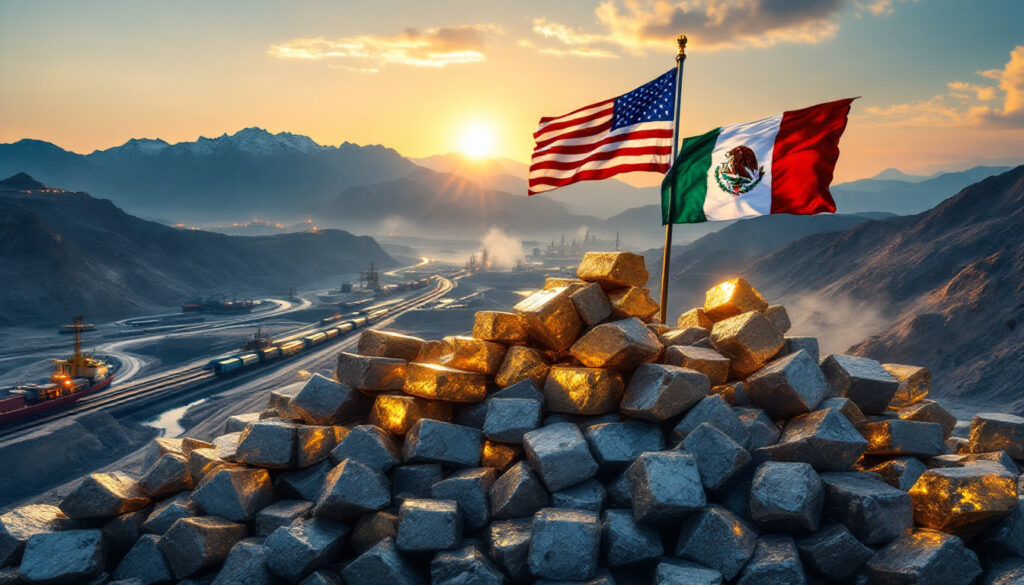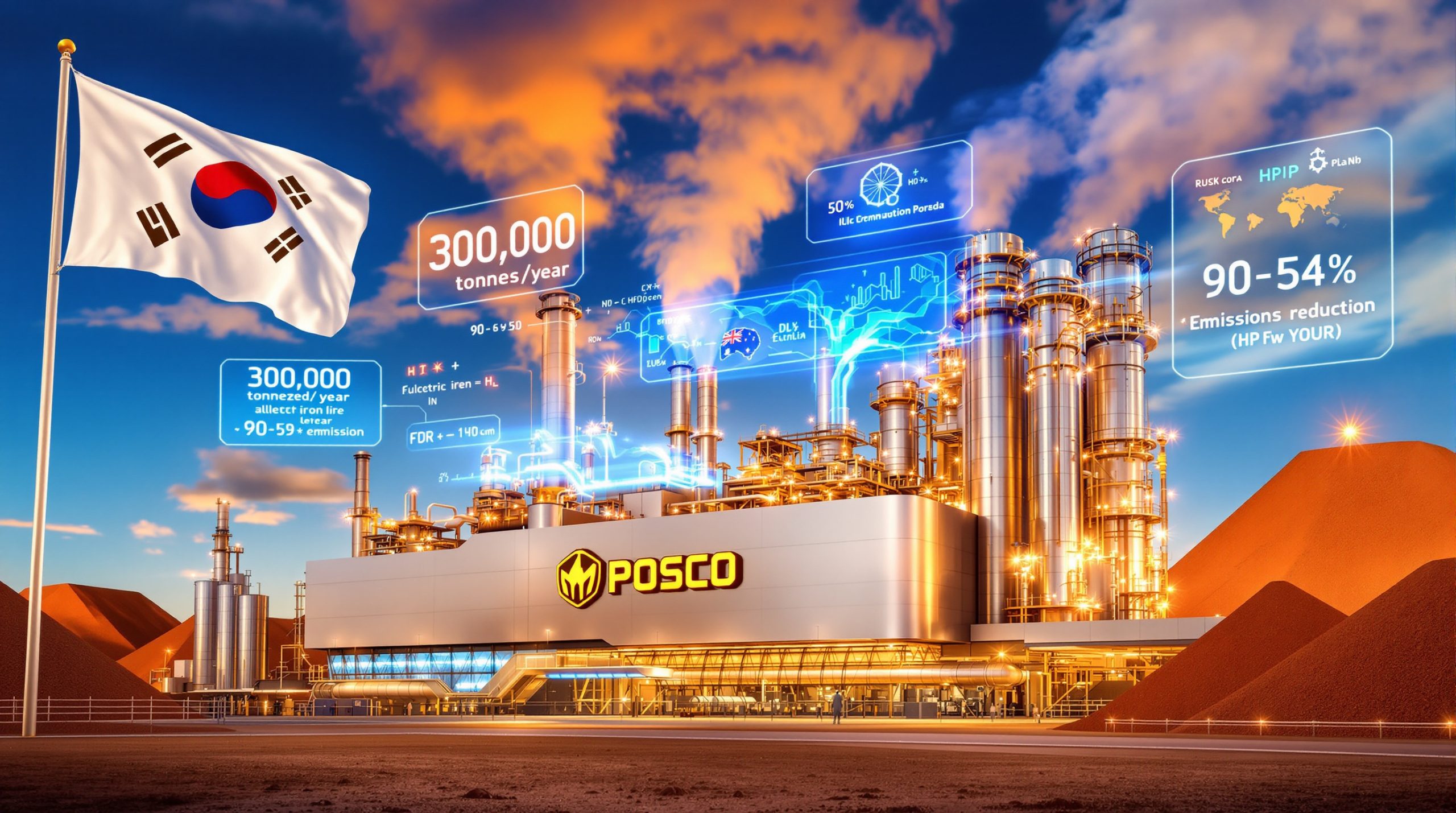How Are Trump's New Tariffs Reshaping Global Mineral Trade?
The recent wave of tariffs imposed by the Trump administration is creating seismic shifts in the global mineral trade landscape, with Latin American mining markets particularly vulnerable to these changes. On March 12, 2025, the US government announced a sweeping 25% tariff on steel and aluminum imports, following earlier threats in January 2025 regarding potential copper import tariffs. These measures build upon the 25% tariffs specifically targeting Mexico implemented on March 4, 2025, and additional tariffs on Canada and China introduced in early 2025.
The strategic importance of Latin America to US mineral imports cannot be overstated. The region accounts for 23% ($18 billion) of US imports in iron, steel, copper, and aluminum. This significance stems from both geographical proximity and the region's abundant mineral resources, which have historically benefited from preferential trade arrangements under various free trade agreements.
While the US administration announced certain exemptions for goods under the US-Mexico-Canada Agreement on March 6, 2025, the overall trajectory signals a profound disruption to established trade patterns. Mining industry analyst Dr. Miguel Cortes notes: "These tariffs represent the most significant challenge to Latin American mineral exporters in decades, threatening well-established supply chains and forcing rapid market diversification."
Despite these exemptions, many Latin American mining operations now face difficult decisions as historical tariff exemptions and preferential arrangements become increasingly uncertain. Companies that have invested heavily in export-oriented infrastructure targeting the US market are particularly exposed to these policy shifts.
What Are the Broader Implications for Latin American Mining Markets?
The ripple effects of these tariffs extend well beyond immediate trade disruptions, forcing Latin American mining operations to rapidly reconsider their market strategy and supply chain structures.
Market Diversification Strategies
Mining companies across Latin America are now accelerating diversification strategies, with the European Union emerging as a primary alternative export market. Industry data suggests EU imports of Latin American minerals increased by 17% in Q1 2025 as companies began redirecting shipments away from the US market.
China also represents a significant opportunity for displaced exports. As noted by Amelia Haines of BMI UK: "Evolving US-China trade dynamics may present opportunities for Mainland China to expand its presence in the region." Chinese buyers have already increased purchases of Brazilian iron ore and Chilean copper in the first quarter of 2025, often at preferential rates as Latin American suppliers scramble to find new markets.
Foreign investment flows are also being restructured in response to changing trade dynamics. Several major mining projects in Mexico and Peru that were originally developed with US export markets in mind are now seeking additional capital to retool operations for alternative markets, sometimes at substantial cost.
"We're witnessing a fundamental restructuring of mineral trade relationships that have been stable for decades. Companies that can quickly pivot to alternative markets will survive; those that cannot may face existential challenges." – Regional mining association statement, March 2025
Supply Chain Disruptions and Realignments
The tariffs are catalyzing a potential reshaping of global mineral supply chains. Critical mineral supply resilience partnerships established under previous administrations are now under threat, creating uncertainty for downstream manufacturers dependent on these materials.
This disruption presents opportunities for new regional trade alliances to emerge. Industry experts point to increased discussions around a potential "Latin American Minerals Consortium" that would coordinate regional processing and marketing efforts to strengthen negotiating positions with alternative buyers.
However, maintaining stable supply during this transition period presents significant challenges. Port congestion at major EU entry points has already been reported as Latin American suppliers rush to redirect shipments, while logistical networks optimized for US export must be reconfigured, often at substantial cost.
How Is Brazil's Mining Sector Specifically Affected?
Brazil's mining sector faces particular vulnerability to the new tariff regime, with its steel industry especially exposed to negative impacts.
Steel Industry Vulnerabilities
The US market represents a crucial 48% ($5.7 billion) of Brazil's iron and steel exports, making the loss of previous exemptions under Section 232 of the Trade Expansion Act particularly damaging. Brazilian steel producers now face the daunting challenge of finding alternative markets amid weak global conditions.
Industry analysts point to persistent overcapacity issues in Brazil's steel sector that are now being exacerbated by these new tariffs. Brazilian mills had invested heavily in capabilities tailored to US market specifications, investments that may now deliver significantly lower returns.
As Brazil's second-largest trading partner, the US imported $11.8 billion in goods from Brazil in 2024, with iron and steel comprising nearly half of this total. Without the Section 232 exemptions, Brazilian producers face an immediate price disadvantage in a market they've spent decades developing.
Investment Strategy Adjustments
Brazilian mining companies are now adopting a cautious approach to new investments amid this market uncertainty. VALE, Brazil's mining giant, has reportedly placed $3.2 billion in expansion projects under review as it reassesses global demand patterns in the wake of tariffs impact markets.
The potential redirection of capital to alternative markets is gaining traction, with Brazilian mining companies increasing their marketing presence in Europe and Asia. Industry associations including the Brazilian Steel Institute and National Industry Confederation are pushing for negotiations with the US administration, leveraging Brazil's position as the US's second-largest iron and steel import market after Canada.
"We're not abandoning the US market, but we must be realistic about the changed economics. Every Brazilian steel company is now developing a 'Plan B' strategy focused on alternative markets." – Brazilian Steel Institute representative
This adjustment period is proving particularly challenging for smaller producers without the resources to quickly pivot to new markets or absorb temporary losses while new relationships are established.
What Opportunities Exist in Critical Minerals Development?
Despite the challenges presented by tariffs on traditional mineral exports, significant opportunities are emerging in the critical minerals sector—an area less impacted by current tariff structures but vital to future technology needs.
Strategic Mineral Positioning
Latin American countries with deposits of critical minerals face potentially bright prospects despite the tariff situation. Lithium resources in Argentina, Bolivia, and Chile—the region's "Lithium Triangle"—represent approximately 58% of the world's known reserves. These resources are increasingly strategic as global demand for electric vehicle batteries continues to grow exponentially.
Mining companies are recognizing potential growth in critical minerals energy transition that remain largely unaffected by current tariffs. This situation creates opportunities to develop value-added processing capabilities within the region rather than simply exporting raw materials.
Several countries are actively pursuing diversification away from traditional steel and aluminum exports. Chile, for example, has launched a national initiative to capture more value from its lithium resources by encouraging domestic battery component manufacturing, potentially creating 5,000 new jobs by 2027.
Strategic partnerships with non-US entities seeking stable mineral supplies are flourishing. European automotive manufacturers have signed preliminary agreements with Brazilian and Chilean mining companies to secure critical mineral supplies for EV production, often including technical assistance for developing higher-value products.
Technology and Innovation Responses
Investment in processing technologies to increase product value represents a promising response to tariff challenges. Companies that can move up the value chain by producing more refined or specialized products often face lower tariff barriers while capturing higher margins.
Colombian mining operations are exploring innovations in copper processing that could yield specialized products for emerging technologies in renewable energy. These higher-value exports typically face lower tariff barriers while commanding premium prices.
Regional governments are also supporting the exploration of domestic consumption opportunities. Mexico's recently announced "Minerals for Mexican Manufacturing" program aims to increase domestic utilization of locally-mined materials by offering tax incentives to manufacturers who source minerals domestically.
The creation of regional processing hubs to serve global markets is gaining traction as a strategic response. Panama and Costa Rica are positioning themselves as potential locations for critical mineral processing facilities that could serve both Asian and European markets, leveraging their geographic advantages and existing port infrastructure.
How Might US-China Competition Influence Latin American Mining?
The escalating competition between the US and China presents both challenges and opportunities for Latin American mining operations, creating a complex geopolitical landscape that savvy players might leverage to their advantage.
China's Expanding Regional Influence
Recent developments present substantial opportunities for China to strengthen mining sector relationships in Latin America. Chinese state-backed companies have already increased their engagement with regional mining operations, with preliminary investments in copper projects in Peru and lithium operations in Argentina announced in recent months.
Industry experts anticipate potential increased Chinese investment in regional mining operations as Beijing seeks to secure vital mineral supplies amid global competition. Chinese companies have demonstrated willingness to invest in processing facilities within Latin America, potentially offering a path to higher-value exports for regional producers.
China's strategic positioning as an alternative market for Latin American mineral exports is accelerating. Chinese buyers have increased purchases of Brazilian iron ore trends by 22% in Q1 2025 compared to the same period last year, according to industry data.
These shifts carry long-term implications for US mineral security and supply chains. As China secures preferential access to Latin American resources, US manufacturers may face increasing challenges in sourcing critical materials, potentially undermining efforts to strengthen domestic manufacturing.
Geopolitical Considerations
The tariff situation is prompting a regional realignment of trade partnerships and strategic alliances. Countries previously firmly in the US economic orbit are now diversifying their relationships, creating new diplomatic and economic dynamics throughout the region.
Latin American nations are discovering leverage opportunities in negotiating new agreements as both Chinese and US interests compete for influence. Chile, for instance, has reportedly secured improved terms in recent mining investment agreements by highlighting competing interest from both American and Chinese firms.
These shifts may impact regional economic integration efforts as countries balance competing pressures from global powers. The Pacific Alliance trade bloc has established a special working group on mineral resources to coordinate regional responses to changing global mining landscape.
What Are the Economic Impacts Beyond Direct Trade?
The effects of tariffs in the Latin American mining sector extend far beyond immediate trade relationships, touching employment, regional development, currency values, and commodity markets.
Employment and Regional Development Concerns
Communities dependent on export-oriented mining operations face potential job losses as companies adjust to new market realities. In Brazil's mining regions, local officials estimate that each mining job supports up to five additional positions in supporting industries, magnifying the potential impact of mining sector contractions.
These challenges are prompting shifts in regional development priorities. Several mining-dependent states in Mexico are accelerating economic diversification efforts, with increased investment in tourism infrastructure and light manufacturing to reduce dependence on mineral exports.
Secondary impacts on supporting industries and services are becoming apparent. Transportation companies specialized in moving minerals to US-bound ports report significant volume declines, with some truck fleet operators in northern Mexico reporting 30% reductions in mineral haulage in Q1 2025.
Some jurisdictions are exploring opportunities for domestic market development as an alternative strategy. Brazil's Minas Gerais state has launched an initiative to connect local mineral producers with domestic manufacturers, offering tax incentives for locally-sourced materials.
Currency and Commodity Price Effects
National currencies of major mining economies have experienced notable volatility following tariff announcements. The Chilean peso weakened by 4.2% against the US dollar in the week following January's copper tariff threats, reflecting market concerns about the country's export outlook.
Commodity price fluctuations due to trade disruptions have been observed across multiple mineral categories. Aluminum prices dropped 3.8% globally after the March steel and aluminum tariff announcement as markets anticipated supply redirection from Latin American producers.
Government revenue from mining royalties and taxes faces potential pressure in several countries. Peru, where mining represents approximately 10% of GDP and 60% of exports, could see fiscal revenues decline by up to $1.2 billion annually if copper exports to the US face sustained tariffs, according to government estimates.
These economic shifts carry significant investment implications for mining companies and shareholders. Several major mining companies with substantial Latin American operations have seen share price declines of 5-15% since the initial tariff announcements, reflecting market uncertainty about future profitability.
How Are Different Countries in the Region Responding?
Latin American nations are developing distinct strategies to address the tariff challenges, with approaches tailored to their specific mineral endowments and trade relationships.
Mexico's Adaptation Strategies
Mexico faces a particularly complex situation as both a USMCA partner and tariff target. The country's mining chamber has established a dedicated task force to work with government officials in seeking exemptions for mineral exports under USMCA provisions, emphasizing integrated supply chains across North America.
Diversification efforts for mineral exports are accelerating, with particular focus on European markets. Mexican silver producers have increased marketing efforts in jewelry manufacturing centers in Italy and Germany, seeking to offset potential US market losses.
Diplomatic approaches to secure exemptions remain a priority. Mexican officials have conducted multiple high-level meetings with US counterparts, emphasizing the integrated nature of North American supply chains and the potential damage to US manufacturers if Mexican mineral inputs face tariffs.
Domestic market development initiatives are gaining momentum. Mexico's industrial development agency has launched a program to connect domestic mineral producers with Mexican manufacturers, offering tax incentives for locally-sourced materials.
Chile and Peru's Copper Export Concerns
Chile and Peru, as the world's top copper producers, are actively preparing for potential copper tariffs hinted at in January's announcements. Chile's copper mining association estimates that tariffs could affect approximately $1.8 billion in exports to the US annually.
Alternative market development is proceeding rapidly. Chilean copper producers report increased engagement with Asian electronics manufacturers, with preliminary agreements for direct supply relationships that bypass traditional trading houses.
Value-added processing investments are accelerating as both countries seek to reduce reliance on raw copper exports. Peru has announced tax incentives for companies investing in copper refinement and semi-finished copper product manufacturing facilities within the country.
Strategic partnerships with non-US buyers are forming quickly. European green energy companies have increased direct procurement activities in both countries, seeking to secure copper supplies for renewable energy infrastructure projects across the EU.
What Are the Long-Term Implications for Global Mining Markets?
The current tariff situation may catalyze structural changes in global mineral markets that outlast the specific policies that triggered them.
Structural Changes in Global Mineral Trade
Industry analysts anticipate potential permanent shifts in established trade patterns as supply chains reconfigure to the new reality. Historical patterns of Latin American minerals flowing primarily to North American markets could be permanently altered, with greater geographical diversification becoming the new norm.
The development of new regional mineral processing hubs appears increasingly likely. Panama, with its strategic canal location, has announced plans to develop advanced processing facilities for various minerals, positioning itself as a potential value-adding intermediary between Latin American producers and global markets.
Changes in investment patterns and priorities are becoming evident. Mining companies are increasingly prioritizing flexibility in export infrastructure, sometimes accepting higher costs to maintain multiple market options rather than optimizing for a single destination.
The evolution of pricing mechanisms and contract structures is accelerating. Spot pricing is gaining importance relative to long-term contracts as producers seek to maintain flexibility in uncertain markets, potentially increasing price volatility for certain minerals.
Sustainability and ESG Considerations
Environmental and social governance initiatives face mixed impacts from the changing trade landscape. Some experts express concern that pressure to quickly find alternative markets might lead companies to engage with buyers having less rigorous ESG requirements than US purchasers.
Regional differences in environmental standards are emerging as competitive factors. Countries with more streamlined permitting processes are seeing increased interest from mining investors seeking to quickly develop new projects oriented toward alternative markets.
Carbon border adjustment mechanisms and their interaction with tariffs present an additional layer of complexity. European markets, while offering alternatives to US exports, increasingly require carbon footprint certification, creating new compliance challenges for Latin American producers.
"The reconfiguration of global mineral markets presents an opportunity to establish higher sustainability standards across all markets, rather than a race to the bottom. Progressive mining companies see this as a chance to differentiate themselves." – Environmental mining consultant, April 2025
FAQs About US Tariffs and Latin American Mining
How do the new US tariffs compare to those implemented in 2018?
The 2025 tariffs mirror the 25% rates on steel and aluminum from 2018 but have significantly broader application and fewer exemptions. While the 2018 tariffs included various country-specific exemptions that evolved over time, the current regime specifically targets certain countries like Mexico with minimal exceptions. Additionally, the potential copper tariffs mentioned in January 2025 would represent an expansion beyond the metals targeted in 2018.
What alternative markets are most promising for Latin American mineral exporters?
The European Union and China represent the most significant alternative markets due to their size and ongoing demand for industrial metals. The EU's green energy transition is driving particular demand for copper and specialized minerals, while China's continuing industrialization maintains strong demand for steel inputs and base metals. Regional trade within Latin America itself is also increasing as countries seek to reduce dependence on US markets, with Brazil's manufacturing sector absorbing more regional mineral production.
How might mining companies adjust their investment strategies?
Mining companies are implementing multi-faceted approaches to address the changing trade landscape. Many are diversifying their customer base across multiple regions to reduce vulnerability to single-market policy changes. Investments in value-added processing capabilities are increasing as companies seek to produce more specialized products that may face lower tariff barriers. Focus is shifting toward minerals less affected by current tariffs, particularly those essential to energy transition technologies. Some operations are being reconfigured to serve multiple markets efficiently, even at the cost of some economies of scale.
What critical minerals present opportunities despite the tariff situation?
Minerals essential for energy transition technologies—including lithium, cobalt, rare earth elements, and certain specialty metals—present significant growth opportunities regardless of US tariff policies. Global demand for these materials continues to increase dramatically, driven by electric vehicle production, renewable energy infrastructure, and advanced electronics manufacturing. Latin America's substantial lithium resources position
Ready to Spot the Next Major Mineral Discovery?
Discovery Alert's proprietary Discovery IQ model instantly notifies investors of significant ASX mineral discoveries, turning complex data into actionable insights that give you a crucial market advantage. Visit the Discovery Alert discoveries page to understand how major mineral discoveries have historically generated substantial returns for early investors.




